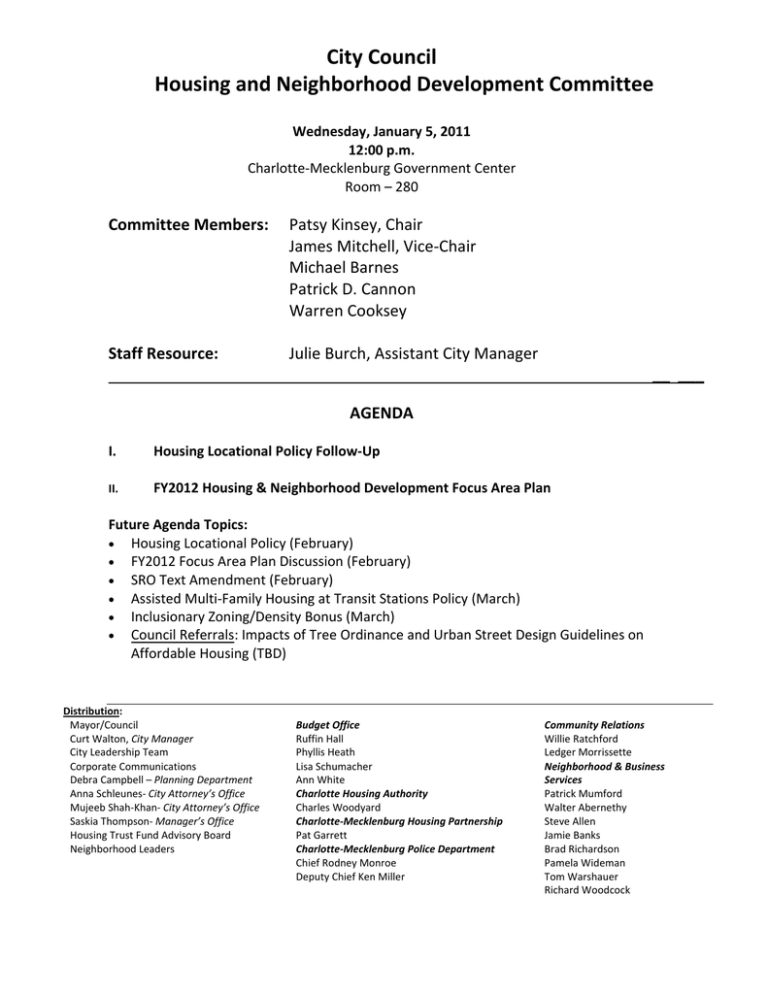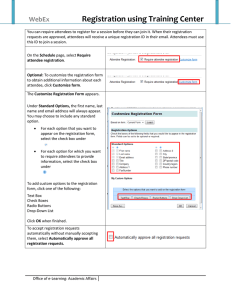City Council Housing and Neighborhood Development Committee
advertisement

City Council Housing and Neighborhood Development Committee Wednesday, January 5, 2011 12:00 p.m. Charlotte‐Mecklenburg Government Center Room – 280 Committee Members: Patsy Kinsey, Chair James Mitchell, Vice‐Chair Michael Barnes Patrick D. Cannon Warren Cooksey Staff Resource: Julie Burch, Assistant City Manager __ ___ AGENDA Housing Locational Policy Follow‐Up II. FY2012 Housing & Neighborhood Development Focus Area Plan Future Agenda Topics: • Housing Locational Policy (February) • FY2012 Focus Area Plan Discussion (February) • SRO Text Amendment (February) • Assisted Multi‐Family Housing at Transit Stations Policy (March) • Inclusionary Zoning/Density Bonus (March) • Council Referrals: Impacts of Tree Ordinance and Urban Street Design Guidelines on Affordable Housing (TBD) I. Distribution: Mayor/Council Curt Walton, City Manager City Leadership Team Corporate Communications Debra Campbell – Planning Department Anna Schleunes‐ City Attorney’s Office Mujeeb Shah‐Khan‐ City Attorney’s Office Saskia Thompson‐ Manager’s Office Housing Trust Fund Advisory Board Neighborhood Leaders Budget Office Ruffin Hall Phyllis Heath Lisa Schumacher Ann White Charlotte Housing Authority Charles Woodyard Charlotte‐Mecklenburg Housing Partnership Pat Garrett Charlotte‐Mecklenburg Police Department Chief Rodney Monroe Deputy Chief Ken Miller Community Relations Willie Ratchford Ledger Morrissette Neighborhood & Business Services Patrick Mumford Walter Abernethy Steve Allen Jamie Banks Brad Richardson Pamela Wideman Tom Warshauer Richard Woodcock Housing Locational Policy Update Housing and Neighborhood Development Committee Meeting January 5, 2011 Committee Action: Receive feedback from the Housing Locational policy follow‐up meeting and seek guidance from the Committee about next steps. On December 16, 2010, staff convened a meeting with citizens who spoke at the November 22, 2010, Housing Locational Policy (HLP) public hearing and other individuals who had previously expressed interest in the HLP. The purpose of the meeting was to clarify concerns and try to reach consensus regarding issues raised about the proposed HLP. HLP Follow‐Up Discussion Points: Five Percent Cap • Attendees asked staff to remember it is important that the policy be written not for today but for where we need to go in the future (to help address the need). • Several attendees commented that the 5% cap is adequate for the current environment while others believe that 5% prohibits us from meeting the needed amount of affordable units. • There was discussion that the intent of the Housing Locational Policy is to avoid an undue concentration of subsidized housing which is primarily those units serving individuals earning 30% and below the median income. Several attendees also commented that the average rent rates for 50% to 60% AMI are around $650 to $700 per month. Therefore, the 5% cap should be placed on housing units serving 30% and below AMI. It was further discussed that a 15% cap could be suitable for the location of new‐multi‐family development in stable NSAs. • Another attendee worried that with the 5% cap and the additional criteria tied to the HLP that opportunities for development are limited. • Another attendee suggested keeping the 5% cap if mixed‐housing is exempt. • Attendees asked that when developing the policy, staff be sensitive to the overburdening of the school system. • The majority of attendees agreed that a 15% cap in Stable NSA’s will give more opportunity for development and actually help address the need. It was also mentioned that with any cap the Housing Trust Fund policy should be revisited. Half‐Mile Restriction • A number of attendees concluded that if the proper percentage cap can be determined, the half‐mile restriction should be completely removed. • Staff was reminded that if the half‐mile restriction remains in the policy, natural barriers should be taken into consideration. • It was also suggested that perhaps a 1/4 mile compromise could be introduced that would line up around the transportation plan. • One attendee cautioned that every restriction added to the policy allows for more debate because restrictions cause the need for waivers. Conversions & Rehabilitations • The majority of attendees expressed that in this economic environment we are not going to be able to build our way out of the issues of affordable housing, therefore conversions and restrictions should be allowed anywhere. • With the emphasis on conversions and rehabilitations it was suggested that the policy allow any amount of conversions in stable neighborhoods. In transitioning and challenged neighborhoods that the 15% and 5% caps should be used as a guide for the numbers of units can that can be converted. • Several attendees commented that conversions improve the physical structure and result in better management and supportive services and are better because the tenant requirements are often stricter than the requirements for a market rate development. • One attendee said that conversions and rehabs could reduce the possibility of gentrification because the units would have affordability periods as a result of receiving a public subsidy. • The majority said that conversions should be allowed. General comments • One attendee suggested that tight restrictions on projects –whether new, conversions or rehabs would not force a redistribution of affordable housing but would prevent the addition of needed units. • Several attendees commented that tight restrictions eliminate sites for developers, inhibit the competitiveness of Charlotte projects for state tax credits and force more projects into the waiver process. With less restrictiveness, the city establishes a policy that affordable housing projects in stable neighborhoods meet public goals and should not be prevented by neighborhood prejudices. • Attendees also commented that the class of exemptions to the policy should be broadened to at least meet the HUD definition of special needs to include both veterans and youth who have aged out of foster care. It was also suggested that public policy should make more sites available to meet the needs of the chronically homeless in our city sighting McCreesh and Moore Place as examples.




